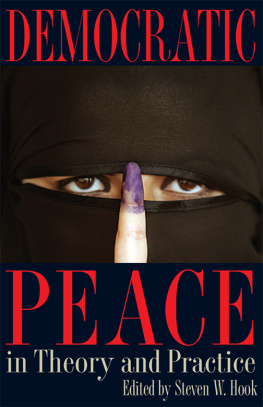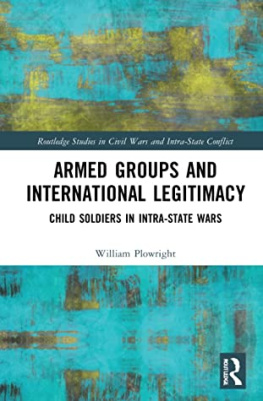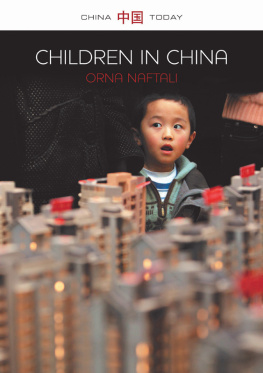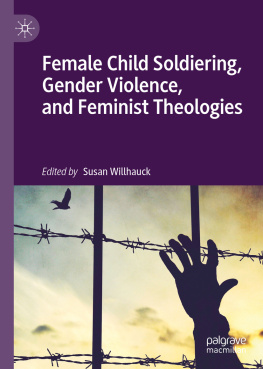TOOLS OF WAR,
TOOLS OF STATE
SUNY series, James N. Rosenau series in Global Politics
David C. Earnest, editor
TOOLS OF WAR,
TOOLS OF STATE
When Children Become Soldiers
ROBERT TYNES
Cover image: Sierra Leone Flag Boy / iStockphoto by Getty Images
Published by State University of New York Press, Albany
2018 State University of New York
All rights reserved
Printed in the United States of America
No part of this book may be used or reproduced in any manner whatsoever without written permission. No part of this book may be stored in a retrieval system or transmitted in any form or by any means including electronic, electrostatic, magnetic tape, mechanical, photocopying, recording, or otherwise without the prior permission in writing of the publisher.
For information, contact State University of New York Press, Albany, NY
www.sunypress.edu
Library of Congress Cataloging-in-Publication Data
Names: Tynes, Robert, 1964 author.
Title: Tools of war, tools of state : when children become soldiers / Robert Tynes, State University of New York.
Description: Albany, NY : State University of New York Press, [2018] | Series: SUNY series, James N. Rosenau series in global politics | Includes bibliographical references and index.
Identifiers: LCCN 2017058954 | ISBN 9781438471990 (hardcover : alk. paper) | ISBN 9781438472003 (ebook)
Subjects: LCSH: Child soldiers. | Children and war. | TacticsCase studies. | TacticsMoral and ethical aspects. | Child soldiersStatistics. | Children and warSierra LeoneCase studies. | Military art and scienceMoral and ethical aspectsCase studies. | WarMoral and ethical aspectsCase studies.
Classification: LCC UB418.C45 T96 2018 | DDC 355.0083dc23
LC record available at https://lccn.loc.gov/2017058954
10 9 8 7 6 5 4 3 2 1
For Maria, Henry, and Julian
Contents
Diagrams and Tables
Diagrams
Tables
Acknowledgments
Without patience, only fear survives. This is what I have learned by researching child soldier use for the past 10 years. After talking with children who fought in battles and with commanders who have faced them, after reading numerous news and NGO reports, and after scouring history for some sign, some hope, that it is abnormal to give children guns, I still see an everlasting, positive movement to keep kids out of war. It takes patience, though, and a network of people reinforcing the norm to protect children.
This book is the result of the help and patience of a huge network of people and organizations. Yes, I did the research and I wrote the text, and I take full responsibility for all of its shortcomings. But it would not have happened without many many people pitching in. First I would to like thank Victor Asal, Erik Hoffman, and David Rousseau of the University at Albany, and Marda Mustapha of the College of St. Rose. They provided critical analysis and insight for my dissertation, from which this book evolved. Victor Asal and David Rousseau were especially essential for the intellectual rigor and discipline they offered. P. K. Muana of Texas A&M University, Marda Mustapha, and members of the Sierra Leonean diaspora on Leonenet were also invaluable contributors to my thoughts concerning the war in Sierra Leone. Barbara Wilkinson and Bryan Early of the Political Science Department at the University at Albany deserve thanks as well for all their help with the regression analysis. The anonymous reviewers for SUNY Press were also key to shaping the final manuscript. Dr. Michael Rinella, Senior Acquisitions Editor, and Diane Ganeles, Senior Production Editor, for SUNY Press turned the manuscript into a bookno easy task.
Much of the early research for this project was refined at various conferences. Some of the concepts and findings from chapter 1 were presented at Forgotten Conflicts: Permanent Catastrophes? a workshop at Colgate University, April 1415, 2007; the 50th Annual meeting of the African Studies Association, October 1821, 2007; and, the 49th Annual International Studies Association Convention, March 2629, 2008. The initial network analysis from chapter 3 was presented at the 5th Annual Network Science Workshop, October 2628, 2010, United States Military Academy, West Point, NY. Elements from chapter 5 were discussed at the Subjects at Risk: Issues and Conduct of DoD Social Sciences Research in War-Torn and Developing Countries workshop, George Mason University, November 1920, 2009. The original work for chapter 5 was first published as Because It Works: The Advantages of Child Soldier Use During the Sierra Leonean Civil War in volume 1 of the Journal of Sierra Leone Studies. I thank editor, John Birchall, for his permission to reprint portions of that article here.
Many aspects of this study were supported by grants from the Joseph Zimmerman Fellowship Award, the Dissertation Research Fellowship Award, the New York State/GSEU Professional Development Award, the University at Albany Graduate Student travel grant, the University at Albany Political Science department travel grant, and the Union of University Professionals professional development award. Fieldwork in Sierra Leone was enabled by the University of Washington Honors Program for which I acted as co-teacher on summer excursions to Kagberre.
Anthropologist Clarke Speed deserves infinite gratitude for his role as the most supportive mentor one could ever have. Without Clarke, I never would have immersed myself as deeply as I have in West Africa. And I continue to say: mi still, still, sabi nuting. Finally, without the love and editorial support from my wife, Maria Simpson, this book would not be. Thank you, Maria.
Why Use Children in War?
Martin P. was a child. He lived in Uganda. He knew how to march in formation, how to load and fire a submachine gun, and how to kill. He fought twice for the Lords Resistance Army (LRA). The LRA kidnapped him for use as a soldier in their insurgency against the Ugandan government. James P. was also abducted by the LRA. He had a similar experience. What did I do with the LRA during my time in captivity? he said, Killed people, beat up people, and looted property. This was under order from the commanders; when we approached a village, some persons would be singled out. We were never told why these people and not others, we were simply told that this one had to be killed (Human Rights Watch, 2003a, p. 10). Both of these boys were caught up in a conflict that has lasted almost 20 years.
In Sri Lanka, a child who trained at the age of 11 to fight for the Liberation Tigers of Tamil Eelam (LTTE), explained how he was programmed to seek revenge for the killing of his friends. He said, he was shown videos of dead women and children and told that his enemies had done this. Soon afterwards he was involved in attacks on several Muslim villages near Batticaloa. When recounting one attack, he described how he had held a child by the legs and bashed its head against a wall and how he enjoyed hearing the mothers screaming. He said they deserved to die (Amnesty International, 1998, p. 38). In 2014, the Islamic State (IS) distributed videos showing toddlers firing weapons they can barely hold (Hilburn, 2014), and kids watching public beheadings, training in hand-hand combat distributing knives to men preparing to behead prisonersand even carrying out executions themselves (Horgan and Bloom, 2015).










